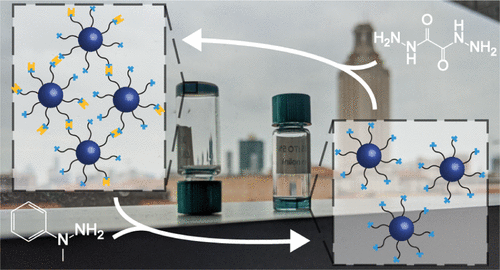当前位置:
X-MOL 学术
›
Chem. Mater.
›
论文详情
Our official English website, www.x-mol.net, welcomes your
feedback! (Note: you will need to create a separate account there.)
Assembly of Linked Nanocrystal Colloids by Reversible Covalent Bonds
Chemistry of Materials ( IF 7.2 ) Pub Date : 2020-11-18 , DOI: 10.1021/acs.chemmater.0c04151 Manuel N. Dominguez 1 , Michael P. Howard 2 , Josef M. Maier 1 , Stephanie A. Valenzuela 1 , Zachary M. Sherman 2 , James F. Reuther 1 , Lauren C. Reimnitz 2 , Jiho Kang 2 , Shin Hum Cho 2 , Stephen L. Gibbs 2 , Arjun K. Menta 1 , Deborah L. Zhuang 1 , Aevi van der Stok 1 , Sarah J. Kline 2 , Eric V. Anslyn 1 , Thomas M. Truskett 2, 3 , Delia J. Milliron 1, 2
Chemistry of Materials ( IF 7.2 ) Pub Date : 2020-11-18 , DOI: 10.1021/acs.chemmater.0c04151 Manuel N. Dominguez 1 , Michael P. Howard 2 , Josef M. Maier 1 , Stephanie A. Valenzuela 1 , Zachary M. Sherman 2 , James F. Reuther 1 , Lauren C. Reimnitz 2 , Jiho Kang 2 , Shin Hum Cho 2 , Stephen L. Gibbs 2 , Arjun K. Menta 1 , Deborah L. Zhuang 1 , Aevi van der Stok 1 , Sarah J. Kline 2 , Eric V. Anslyn 1 , Thomas M. Truskett 2, 3 , Delia J. Milliron 1, 2
Affiliation

|
The use of dynamically bonded molecules designed to reversibly link solvent-dispersed nanocrystals (NCs) is a promising strategy to form colloidal assemblies with controlled structures and macroscopic properties. In this work, tin-doped indium oxide NCs are functionalized with ligands that form reversible covalent bonds with linking molecules to drive assembly of NC gels. We monitor the gelation by using small angle X-ray scattering and characterize how changes in the gel structure affect the infrared optical properties arising from the localized surface plasmon resonance of the NCs. The assembly is reversible because of the designed linking chemistry, and we disassemble the gels using two strategies: addition of excess NCs to change the ratio of linking molecules to NCs and addition of a capping molecule that displaces the linking molecules. The assembly behavior is rationalized using a thermodynamic perturbation theory to compute the phase diagram of the NC–linking molecule mixture. Coarse-grained molecular dynamics simulations reveal the competition between the loop and bridge linking motifs essential for understanding NC gelation. This combined experimental, computational, and theoretical work provides a platform for controlling and designing the properties of reversible colloidal assemblies that incorporate NC and solvent compositions beyond those compatible with other contemporary (e.g., DNA-based) linking strategies.
中文翻译:

通过可逆共价键连接的纳米晶体胶体的组装。
设计用来可逆地连接溶剂分散的纳米晶体(NC)的动态键合分子的使用是形成具有受控结构和宏观特性的胶体组件的一种有前途的策略。在这项工作中,掺杂锡的氧化铟NC被配体官能化,该配体与连接分子形成可逆的共价键,从而驱动NC凝胶的组装。我们通过使用小角度X射线散射监测凝胶化,并表征凝胶结构的变化如何影响由NCs的局部表面等离振子共振引起的红外光学性能。由于设计的连接化学,组装是可逆的,我们使用两种策略来分解凝胶:添加过量的NC来改变连接分子与NC的比例,以及添加取代连接分子的封端分子。使用热力学扰动理论来合理化组装行为,以计算NC连接分子混合物的相图。粗粒度的分子动力学模拟揭示了理解NC凝胶必不可少的环和桥连接基序之间的竞争。这种结合了实验,计算和理论上的工作,为控制和设计可逆胶体组件的性能提供了一个平台,该组件结合了与其他现代(例如基于DNA)连接策略不兼容的NC和溶剂成分。粗粒度的分子动力学模拟揭示了理解NC凝胶必不可少的环和桥连接基序之间的竞争。这种结合了实验,计算和理论上的工作,为控制和设计可逆胶体组件的性能提供了一个平台,该组件结合了与其他现代(例如基于DNA)连接策略不兼容的NC和溶剂成分。粗粒度的分子动力学模拟揭示了理解NC凝胶必不可少的环和桥连接基序之间的竞争。这种结合了实验,计算和理论上的工作,为控制和设计可逆胶体组件的性能提供了一个平台,该组件结合了与其他现代(例如基于DNA)连接策略不兼容的NC和溶剂成分。
更新日期:2020-12-08
中文翻译:

通过可逆共价键连接的纳米晶体胶体的组装。
设计用来可逆地连接溶剂分散的纳米晶体(NC)的动态键合分子的使用是形成具有受控结构和宏观特性的胶体组件的一种有前途的策略。在这项工作中,掺杂锡的氧化铟NC被配体官能化,该配体与连接分子形成可逆的共价键,从而驱动NC凝胶的组装。我们通过使用小角度X射线散射监测凝胶化,并表征凝胶结构的变化如何影响由NCs的局部表面等离振子共振引起的红外光学性能。由于设计的连接化学,组装是可逆的,我们使用两种策略来分解凝胶:添加过量的NC来改变连接分子与NC的比例,以及添加取代连接分子的封端分子。使用热力学扰动理论来合理化组装行为,以计算NC连接分子混合物的相图。粗粒度的分子动力学模拟揭示了理解NC凝胶必不可少的环和桥连接基序之间的竞争。这种结合了实验,计算和理论上的工作,为控制和设计可逆胶体组件的性能提供了一个平台,该组件结合了与其他现代(例如基于DNA)连接策略不兼容的NC和溶剂成分。粗粒度的分子动力学模拟揭示了理解NC凝胶必不可少的环和桥连接基序之间的竞争。这种结合了实验,计算和理论上的工作,为控制和设计可逆胶体组件的性能提供了一个平台,该组件结合了与其他现代(例如基于DNA)连接策略不兼容的NC和溶剂成分。粗粒度的分子动力学模拟揭示了理解NC凝胶必不可少的环和桥连接基序之间的竞争。这种结合了实验,计算和理论上的工作,为控制和设计可逆胶体组件的性能提供了一个平台,该组件结合了与其他现代(例如基于DNA)连接策略不兼容的NC和溶剂成分。











































 京公网安备 11010802027423号
京公网安备 11010802027423号